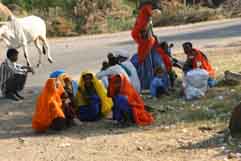Special Feature: Products Sally Recommends
Have You Seen Tigers in the Wild?
 “Stop the Jeep” our guide Ashlesh calls to our driver in a loud whisper. And as he does so, all four passengers sitting in the open safari top vehicle fall silent. We look around and listen. The surrounding jungle has also become very quiet, except for the occasional staccato squawk of a monkey. Something unusual is happening.
“Stop the Jeep” our guide Ashlesh calls to our driver in a loud whisper. And as he does so, all four passengers sitting in the open safari top vehicle fall silent. We look around and listen. The surrounding jungle has also become very quiet, except for the occasional staccato squawk of a monkey. Something unusual is happening.
“That is a warning call” whispers our knowledgeable guide. “There are tigers about”. Ashlesh now tells the driver to move the Jeep slowly forward. And as we round the corner, our guide points to a tree in the middle distance. There, sitting on one of the lower branches, is a magnificent female tiger at rest. She watches us carefully, but does not move. Nearby, on a pebbly patch, two grown tiger cubs are playing. They are almost full-sized and are equally magnificent.
I lift my camera to take pictures, and it is one of the most frustrating moments of my life, as the lens shutter jams and freezes. “Don’t worry says Ashlesh, I will take those pictures with mine!” Within minutes he has taken some of the best tiger shots I have seen.
In the meantime, the mother has got up and gracefully tip-toed across the tree branch and down onto the ground. She now heads for a shallow roadside pond, and lies down in the water to cool off, shortly to be followed by her two youngsters. Just these few minutes are enough to make the whole India trip more than worthwhile. With the latest reports showing that there are now only 1,411 tigers left of the 40,000 plus that lived in India around 1900, to see three on one morning is nothing short of sensational.
 We had wanted to see tigers in the wild during our last three trips to India, but this was the first time that we struck it lucky. We are in the jungle of the Rathambore National Park, a remarkable wild-tiger sanctuary located near the fortress of Rathambore, founded in 944 by the Chauhan Rajputs. The ruins of the old fort are some of the largest in India and can be seen looming over the park as one drives in through the gates. Throughout the last 1,000 years this park has been home to tigers and before their hunting became illegal, this was a favourite royal hunting ground for the successive Maharajas who ruled the area.
We had wanted to see tigers in the wild during our last three trips to India, but this was the first time that we struck it lucky. We are in the jungle of the Rathambore National Park, a remarkable wild-tiger sanctuary located near the fortress of Rathambore, founded in 944 by the Chauhan Rajputs. The ruins of the old fort are some of the largest in India and can be seen looming over the park as one drives in through the gates. Throughout the last 1,000 years this park has been home to tigers and before their hunting became illegal, this was a favourite royal hunting ground for the successive Maharajas who ruled the area.
Today the National Park is a walled off area which still contains some ancient temples and monuments, but is mainly famous as a nature reserve that sharply contrasts to the busy, often-clogged, streets of nearby Rathambore town. In the park everything has been left as natural as possible, and today the park is home to tigers, leopards, striped hyenas, sambar deer, peacocks, monkeys, pythons, sloths, bears and lots of other animals. It also has some shallow lakes, and these are home to Egyptian crocodiles that were imported after the local Maharajah visited Africa.
 As we sit in our Jeep to watch these magnificent tigers, our guide has been sending out word on his walkie-talkie, and in minutes other Jeeps start to converge on our viewing-spot. It is time for us to move on.
As we sit in our Jeep to watch these magnificent tigers, our guide has been sending out word on his walkie-talkie, and in minutes other Jeeps start to converge on our viewing-spot. It is time for us to move on.
At every turn of the road we see new wonders. Deer feeding in the tall grass, peacocks strutting across the fields, crocodiles sunning themselves on the shores of the waterholes, monkeys watching us from low trees and from the ground, wild boar cantering to head for nearby trees – the whole time we are in the park the terrain changes from open savannah with watering holes, to granite-faced cliffs, forest and tropical jungle. The terrain is as mixed as the variety of animals we see. This is, without doubt, the best and most serendipitous national park we have seen in India.
There are two jungle safaris per day that operate in the park early morning and late afternoon and we have chosen the latter and now the sun is setting, it is time to get back to our tented camp. But what a camp this is! If you have a pre-conceived idea of what tent-living is all about, simply forget it, because the tents of Aman-I-Khas, located 3½ hours by car from Jaipur are totally amazing – and incredibly luxurious.
This jungle resort is set in a quiet side road, not far from the entrance to the National Park. Totally without signage or fanfare, the gated entrance is guarded by one of the staff, and once inside the property you find yourself treated like a Maharajah.
The property itself is landscaped to blend in with the natural surroundings. It consists of ten super-luxurious tents that are, each year, pulled down as the monsoon season approaches, and re-erected on concrete slabs (which are the only items remaining on site during the monsoon) as soon as this season is over.
 The tents themselves comprise of four “room areas” – bedroom, bathroom/toilet, lounge and enclosed verandah. Nothing detracts from complete comfort and luxury. Air-conditioning? Certainly! Hot water and finest cosmetics? Of course! Room service? Naturally! Everything is there except television, and even that is available in the special library-tent near the dining room. Here one can relax to browse through novels and magazines or enjoy beautifully illustrated coffee table books about the National Park, tigers, the history and culture of Rajasthan, or listen to a range of CD’s through personal CD players that do not infringe on other guests. Nearby, a spa tent offers Indian massage for those muscles tired out by balancing in the bucking Jeeps. This is glamour-camping taken into an artform.
The tents themselves comprise of four “room areas” – bedroom, bathroom/toilet, lounge and enclosed verandah. Nothing detracts from complete comfort and luxury. Air-conditioning? Certainly! Hot water and finest cosmetics? Of course! Room service? Naturally! Everything is there except television, and even that is available in the special library-tent near the dining room. Here one can relax to browse through novels and magazines or enjoy beautifully illustrated coffee table books about the National Park, tigers, the history and culture of Rajasthan, or listen to a range of CD’s through personal CD players that do not infringe on other guests. Nearby, a spa tent offers Indian massage for those muscles tired out by balancing in the bucking Jeeps. This is glamour-camping taken into an artform.
Before dinner, guests gather at a large open-air seating area, the centrepiece of which is a roaring bonfire. While friendly waiters ply guests with the drinks of their choice, this is the time when everybody talks about their days sightseeing experience, while enjoying the vista that overlooks the plain across to the Aravalli Hills. Then it is time to move into the dining tent, where one enjoys some of the best cuisine in India, with a choice of Indian or Western dishes. Aman Resorts don’t do things by halves!
And if you want to really round out your Rajasthan luxury experience, here is an insider tip – plan for a few days at Aman-I-Khas sister resort, Amanbagh, located 3½ hours by car (the resort will organise your transfer by private car) in a valley that, seemingly in the middle of nowhere, is another fabulous, luxury hideaway of the Rich and Famous.
 Amanbagh has to be seen to be believed. Set out like an Indian palace and surrounded by eucalypts, palms, fruit trees and indigenous species, it is located in a walled compound that was once a staging area for royal Moghul hunts. Stay here and you will know the luxury experienced by Indian Maharajas. Picture, in your mind, 24 Haveli suites and 16 pavillions set in manicured gardens and serviced by over 200 staff, and you will start to get a feel for the sort of service that most mere mortals can only dream about. Mirrored pools, suites the size of a small home, delicious cuisine, a wonderfully relaxing and yet elegant atmosphere all come together to make this one of the most elegantly wondrous luxury hideaways in India. But here again, it is the Jeep excursions made available by the resort that will make your stay here so memorable.
Amanbagh has to be seen to be believed. Set out like an Indian palace and surrounded by eucalypts, palms, fruit trees and indigenous species, it is located in a walled compound that was once a staging area for royal Moghul hunts. Stay here and you will know the luxury experienced by Indian Maharajas. Picture, in your mind, 24 Haveli suites and 16 pavillions set in manicured gardens and serviced by over 200 staff, and you will start to get a feel for the sort of service that most mere mortals can only dream about. Mirrored pools, suites the size of a small home, delicious cuisine, a wonderfully relaxing and yet elegant atmosphere all come together to make this one of the most elegantly wondrous luxury hideaways in India. But here again, it is the Jeep excursions made available by the resort that will make your stay here so memorable.
One of these takes you through tiny villages to explore the real Indian rural lifestyle. Another will take you to fascinating century-old abandoned towns, whose temples and walls allow you to half close your eyes and let your imagination take you back over 200 years to the time when this was one of the most thriving urban areas in India. Now abandoned, only the soft wind that drifts over the fields shares this memory.
 India keeps drawing me back and back – always interesting and always fascinating. And if you, like myself, fall in love with this incredible land, then don’t miss a visit to these two places in Rajasthan. And if you are lucky, you may be joining me in being one of the last generation of humans who have the opportunity of finding tigers in the wild.
India keeps drawing me back and back – always interesting and always fascinating. And if you, like myself, fall in love with this incredible land, then don’t miss a visit to these two places in Rajasthan. And if you are lucky, you may be joining me in being one of the last generation of humans who have the opportunity of finding tigers in the wild.
Resources:
GETTING THERE: Fly into Jaipur and pre-arrange a pick-up to both resorts.
FOR MORE INFORMATION GO TO: www.amanresorts.com
AMAN-I-KHAS is open between October 1 – April 30 each year.
TAKE: Comfortable, but stylish resort gear for Amanbagh, and safari-type casual clothing and footwear for Aman-I-Khas. Take a good SLR camera with telephoto lens – preferably 18-250 range. Also wide brimmed hats, sunscreen, insect repellent and swimwear (for both resorts).
We recommend that you do not attempt to self-drive in India !!
Note: This information was accurate when it was published. Please be sure to confirm all rates and details directly with the businesses in question before making your plans.



